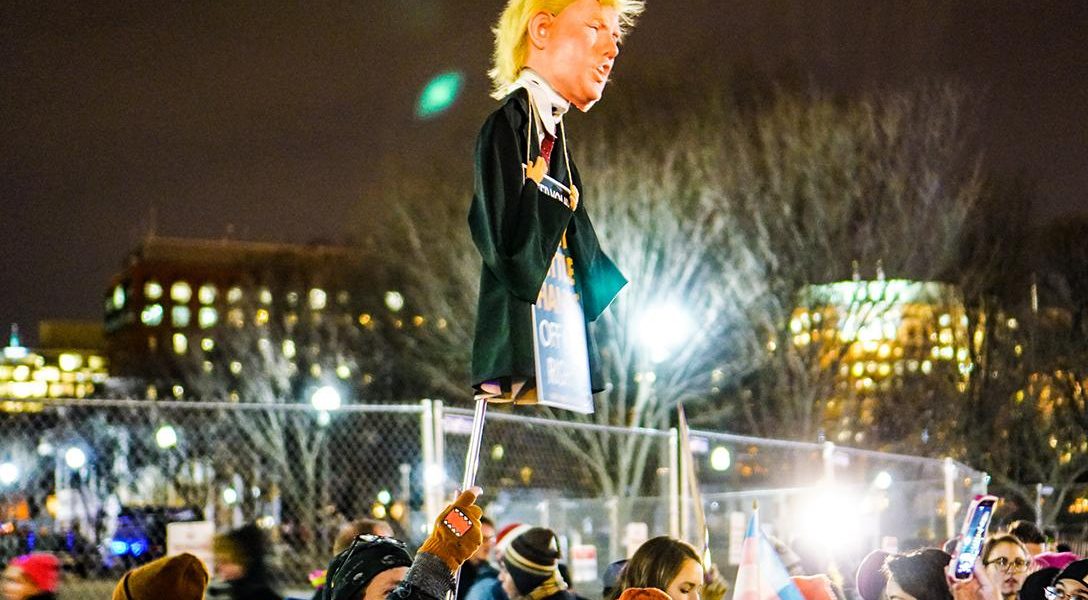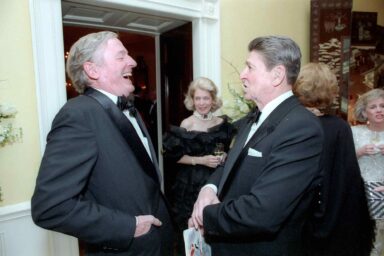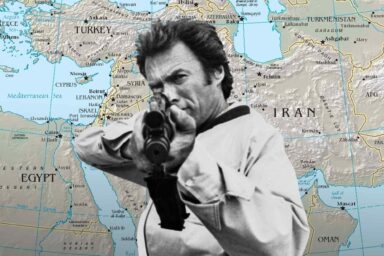What Is the Endgame of the “Resistance?”
Will protest and grassroots organizing make any difference against the Trump administration?
People are protesting Trump, but to what end? If protest is just directed at a person and not a policy, is it any good for the country and does old style grassroots protest even have a place today? Longtime grassroots political organizer L.A. Kauffman discusses this and more.
Since the Women’s March on January 21, protest and resistance to the Trump administration has been non-stop. Overall, it’s been directed less at policy than at Trump and other members of the administration. What’s the endgame of that effort?
Longtime grassroots political organizer L.A. Kauffman tells WhoWhatWhy’s Jeff Schechtman that “the goal is to create crisis.” But is that really good for the country?
In the 1960’s, protest had a specific aim: End the war, ensure civil rights, women’s rights, etc. Today, though, the protests seem to be about making the participants feel good, without any real goal in sight.
Kauffman also talks about whether traditional grassroots efforts can be sustained in this era of short attention spans and social media, and if there isn’t a kind of retro quality to protests that are directed against a disruptive political regime. Just as the Trump campaign was able to triumph over traditional political campaign organizing, Kauffman asks if traditional protest techniques will have any better luck. Also addressed in this week’s podcast is the question of celebrity culture, and what’s the value and importance of charismatic leadership in any protest effort?


Click HERE to Download Mp3
Full Text Transcript:
As a service to our readers, we provide transcripts with our podcasts. We try to ensure that these transcripts do not include errors. However, due to a constraint of resources, we are not always able to proofread them as closely as we would like and hope that you will excuse any errors that slipped through.
Jeff Schechtman: Welcome to Radio WhoWhatWhy. I’m Jeff Schechtman.
For those of us that grew up in the 60s, we all remember well the protests of the civil rights era, the protests against the Vietnam War, protests and push back to power that were modeled on similar historical efforts. But today in an era of disruption, of social media, of short attention spans, and siloed political views enhanced by the long tail of technology, can similar kinds of protest and direct action even work? Can traditional protest even make a dent against a disruptive regime? Can protest be directed at just an individual versus a policy? And if so, does there need to be an equally charismatic leader as the head of the protest?
We’re going to talk about that today with my guest, L.A. Kauffman. L.A. Kauffman has spent more than 30 years immersed in radical movements as a journalist, historian, organizer, and strategist. Her writings on grassroots activism and social movement have been published in numerous publications, and she’s been part of many successful direct action campaigns. It is my pleasure to welcome L.A. Kauffman here. L.A. Kauffman, thank you so much for joining us.
L.A. Kauffman: Thank you so much for having me, Jeff.
Jeff: So much has been disrupted today in virtually every aspect of our lives, in businesses, in sectors all across the board. Is there any reason to think the protest today, that direct action today, has to look at new ways of approaching itself? That the old models just don’t work anymore?
L.A.: I think some of the models work and some of them don’t. The question of how you organize a successful protest is always contextual. You can’t in the same way that you can’t use a hammer to do every repair that you’d like to do around the house. There’s a whole range of tools in the toolbox of protest movements and some of them work well in some context, and don’t work at all in others. So it’s hard to generalize, but I think, you know, I think there’s a lot of evidence that protests still do very much have an effect, including the ones that have been unfolding before our eyes in the last few weeks.
Jeff: Is there a difference between local protest, local direct action efforts, which certainly can be successful and you can immediately see the results from, and more national, more global, kind of efforts?
L.A.: Well, I think you invoke the keyword by talking to the key phrase by talking about immediate results. You know, when protests work, it’s often hard to pin down what their effect is in the short term. A lot of times you need a longer historical view to see what they do and don’t accomplish. And that’s particularly true when it’s something, for example, like the women’s marches that happened on January 21st, which you know were not about pressuring for a specific narrow policy change that then you can say, well the change happened or didn’t. When protests are part of a larger effort at movement building, and something that’s happening on a longer time frame, you can’t really look back and say, “Well, this happened last week, was it a success or failure?” You can’t tell yet until it’s played out over longer time. Some of the things that I write about in my book are events like, there was a massive, very unknown protest against the Vietnam War in May Day ’71, that arguably, there’s a lot of evidence that it hastened the end of the Vietnam War. But everyone called it a disaster afterwards, and considered it a complete flop as a protest.
Jeff: You talk about the long-term effects of some of these efforts, like the woman’s march for example, but in looking at the short attention spans that people have these days, the way news cycles work, the way information travels, does the long run mean the same thing today as it might have meant 40-50 years ago?
L.A.: Hmm, I think I’m not sure what you’re getting at with that question. Because, you know, I think people are thinking on different time horizons right now, who are organizing now to respond to Trump. There’s a lot that’s happening that’s defensive and reactive. You know, people rushed out to the airport after the first Muslim ban was instituted. But people are also being very thoughtful about discussing new ways of re-engaging with the electoral process and the Democratic Party. People are thinking about the 2018 elections. They’re thinking about 2020 and the redistricting that’s going to take place. So, you know, I see people really looking right now to engage at kind of a different time scale, simultaneously with the recognition that simply being out in the streets, and trying to say no to the damage that’s unfolding now, isn’t going to be adequate to turn the country around.
Jeff: Right, and I guess what it goes to the heart of is that nexus between grassroots political organizing and larger protest movements.
L.A.: Right, I mean, you know, sometimes I think for example what’s happening with the women’s march, you know, a lot of times when you see a huge mobilization like that, that comes out of years of organizing, that there’s been years of buildup, and you’ve got to find organizations that mobilize their base and their members to come. The women’s march was completely different. It started as a Facebook post and it was essentially self-mobilized. You know, although people have scurried to bring their organizing skills to make the local event happen around the country, it wasn’t coming out of an existing organizational structure. People now are trying to build organization out of that, and in fact, in the weeks after the women’s march, there were more than 5,000 local meetings by people who attended that march, and are trying to now build something more long-term. So that’s part of what I say, where you can’t yet judge what the effect of it is going to be. What’s going to come out of those 5,000 local groups? What kind of initiatives are they going to work on? What are they going to engage with in the months and years to come? It’s still unknown, but it’s very intriguing and very promising to have that much local organizing sparked out of that one day of mobilizing.
Jeff: One of the things you talk about, and certainly it goes to the heart of this way news cycles work today, the way in which we get so much information, is the danger of burnout.
L.A.: Oh, that’s a big danger, and obviously since I’m someone who has managed to stick around doing organizing for more than 30 years, I’ve gone through phases of it. You know, if you’re doing this for the long run, you have to take breaks, and, you know, take time away from other parts of your life. But I think that the character of activism and organizing is also a big factor in either avoiding burnout or encouraging it. Activism has to speak to the soul in some way for it to be sustainable. That can look like having art be a central part of your organizing work, or bringing music into a mobilization. It can look like having small group meetings where people really connect deeply and build a sense of community as they’re organizing. It can look like bringing fun and mischief into the movement. You know, all of those things are not kind of window-dressing or add-ons, but they’re part of how people keep their, you know, can keep their tanks full so that you can continue pushing forward in the face of what can be, you know, a discouraging short-term result. Because often times, and certainly in this era, given the amount of institutional power that the Trump administration has, we’re going to lose a lot. There’s going to be a lot of battles we’re going to lose. And we’re going to lose often before we really start to steadily win again, in some, you know, in kind of positive, expansive way. Our victories now are mostly going to be negative ones, and the things that we stop. So, to not burnout in that process, you need more than just standing in the streets and saying no. You need the many kind of yes-es and compositive senses of connection that can come from movements that have joy and collective connection, kind of embedded in the work that they do.
Jeff: Is there a danger in all of that, that it becomes too self-referential, that it makes those involved feel good, but its long-term impact is limited?
L.A: I mean it depends on what you’re doing. I don’t really see that. I don’t think people get involved in movements just for the experience of being inside them. I think it’s hard work, and people do it out of a real deep passion and commitment. So, you know, creating movements that have elements of pleasure in the participation as part of the mix of the hard work, I think that’s just smart organizing.
Jeff: To what extent though is the danger, talking to people that already believe the way you do, and the difficulty of getting the message out there to people that don’t, in this day and age?
L.A.: Right, I don’t think the way we win is by… I think the way that we win, the way that movements win, is by staying true to a vision and an agenda, and pushing that forward with persistence and boldness. That doesn’t always in the short run win people over, in the middle. In fact, sometimes what movements do in the short run is they polarize, and they push some people away. Usually the way that movements gain majority popular support is by winning. There’s nothing like winning to rally people to your side. And you have to be willing to be a little unpopular along the way, and to recognize that some of what you’re doing often, a lot of what you’re doing, is going to be criticized as being too divisive or not polite, or not the right approach. There’s always a lot of naysayers when you’re doing this kind of work.
Jeff: I guess that’s really the question and what I was trying to raise before in terms of the difference between doing it on a local level, on a local issue, or a local cause, as opposed to these national movements, is that on the national level, people are just so incredibly polarized at this point. One wonders what the object of the exercise actually is.
L.A.: Well, right now the object of the exercise is to keep the Trump administration in a state of crisis. That’s our job right now. That’s the job of the resistance and we’re doing it very well. We’ve done a very good job so far at slowing the speed of the rollout of executive orders. They have done less than they intended to do, they’ve had to scale back and limit what they’re doing, and they have been finding themselves challenged and we’re helping to keep them a little off balance as they try to figure out how to implement their agenda. That’s not the long-term work of retaking the Congress, or shifting the direction of the country, but it’s an essential job now, and I think, you know, that the resistance movements that have arisen in the short span of time since the inauguration have been continually surprising, not just in their scale, but in their breadth, in the unlikely places that resistance to Trump is coming from, whether it’s Teen Vogue or the National Parks Service. So I’m feeling that in this current moment, we’ve been extraordinarily effective.
Jeff: Talk a little bit about the role of the media in this effort as you see it.
L.A.: Smart organizers always say you don’t talk to the media, you talk through the media. That you think of the media as a vehicle to try to get your message out, rather than an end in itself. Obviously, we’re in a very different media environment than the movement in the 60s when there were a handful of legacy outlets who told stories that the whole country listened to. We have so many outlets and they are so ideologically polarized that when you’re speaking, you’re not often speaking to a broad national audience, whatever you’re doing. So it’s, you know, it’s a bit different in the way that people have to interact with the media environment now, but I think that, you know, there’s also the great advantage now that people have much more ability to create their own media, whether it’s through spreading messages on Twitter or through creating their own websites, and podcasting, live streaming from protests. You know, the indie-media movement of the 90s, and into the early 2000s, you know, now, now is kind of a whole ethos of independent journalists communicating from the frontlines of these actions, in a way that is, you know, steps around the traditional gatekeepers.
Jeff: How important is anger and keeping up a certain level of anger in all of this?
L.A.: Well, anger is obviously fuel for resistance. There’s many good reasons to feel angry, and some of the most powerful movements of what I think of as having the most effective movement of the last 40 years, ACTUP, the most affected single movement organization which savedmillions of lives by transforming the way that even medications that are tested and released. Their activism was profoundly fueled by anger, but over time, this gets back to the things I was saying before about avoiding burnout. Anger is corrosive over time, it’s difficult to be in the mode of anger all the time and not have it leave you feeling diminished. So that’s one of the challenges when you’re in a period where there’s a lot to say no to, is how to organize ins a way that is also elevating and uplifting positive visions of a different world, something that you can hold onto and feel hopeful about so that you’re not constantly in the key of anger.
Jeff: And is social media, and all that goes along with it, critical to organizing today?
L.A.: It’s a very powerful communications tool. It’s obviously you’re able to reach many more people at far less financial cost than movements were able to often in the past. Just the cost of postage to send out mailings for movements before the age of the Internet was, you know, a factor that people had to contend with. It’s not there now. That said, I don’t think that social media substitutes for organizing, and that people will often just see the way in which movements are discussed online. People made that mistake a lot with Black Lives Matter, thought of it as being primarily a Twitter movement, and didn’t see the organizing structures and networks that were behind it, that were less visible. There’s still a need for a lot of the time-honored techniques of organizing. Social media is a great amplifier and communicator, but if you don’t have the solid organizing behind it, you find yourself creating things that can maybe have an impact in a three-hour time period and then fade away.
Jeff: What did we learn from looking at the Tea Party?
L.A.: Well, we learned that they learned from us, first of all. Everybody’s saying let’s look to the example of the Tea Party. And the Tea Party learned what it did, from our side, from the Left. And we should remember that, and honor the long standing traditions of organizing resistance that we come out of. But the Tea Party, you know, what they did that the Left hasn’t done as much of until recently, is really bring the energy of protest right into the Republican Party. And we have not really done that to the same degree with the Democratic Party. People are starting to do that to say, “How do we take an activist energy and really retake this Party from the grassroots up?” So that part of the model, I think absolutely, people are looking to now. You know, the Tea Party, of course, had funders who were steering its agenda. It was in some ways a grassroots movement, it was in other ways an Astroturf movement. I think the kind of things that we’re seeing with the indivisible groups that have sprung up around the country, there’s more than 5,000 of those as well. So if you add up the small groups that came out of the women’s march, and the indivisible groups, we’re now talking about a really sizable number of local organizing efforts underway. I think the fiery town hall meetings that we saw last month, are just the beginning, of what I think what we’ll be seeing from those groups. So I think people are very much on track to be engaging in a much more activist way with the electoral arena than the Left has done for some time.
Jeff: How important is charismatic leadership at these movements?
L.A.: Not very. Not very. We’ve moved away from a model of having charismatic leaders. People rejected that decades ago, especially since most of them were men, and most of them were white men. And rarely did they lead organizations that had truly democratic participation. We’ve shifted to models of leader-full movements, with many leaders, and many voices where there is not a single charismatic figure at the helm. That was a move for a lot of reasons. There was a lot of deep political thinking behind that shift, and it was also a response to the way in which having a charismatic leader makes a movement vulnerable, as we’ve seen charismatic leaders can be assassinated with great consequences. Movements that use models of collective leadership are more resilient over time.
Jeff: But of course in the realm of electoral politics, which is ultimately the object, a significant object of the exercise, that leadership becomes more important.
L.A.: I come from a perspective where I think of no matter who we elect, we need movements on the outside pressuring them to keep them honest, and providing them with political cover, so that they can do the work that they want to do. So for me, my focus is always on the collective endeavor, not on the target leader. The target is an ally of ours, and someone who we might wish to see move on to higher and higher office.
Jeff: L.A. Kauffman. L.A., I thank you so much for spending time with us here on Radio WhoWhatWhy.
L.A.: Thank you so much for having me Jeff. It’s been a pleasure.
Jeff: Thank you. Thank you for listening and joining us here on Radio WhoWhatWhy. I hope you join us next week for another Radio WhoWhatWhy podcast. I’m Jeff Schechtman.
If you liked this podcast, please feel free to share and help others find it by rating and reviewing it on iTunes. You can also support this podcast and all the work we do by going to www.WhoWhatWhy.org/donate.
Related front page panorama photo credit: Adapted by WhoWhatWhy from DC protest (ResistFromDay1 / Flickr – CC BY 2.0).



